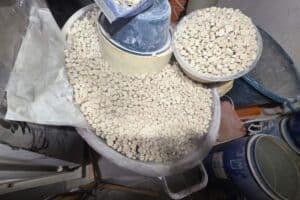Growing hyacinth and nutrient pollution remain critical threats to the dam ecosystem.

There is something fishy killing fish in the hyacinth-infested Hartbeespoort Dam in the North West, with authorities unable to find the cause.
This is after a fish deaths incident occurred on 18 October at the canal of Venice Village Estate, in the dam area.
According to Magalies Water, which is responsible for the dam’s water quality management, the dead fish were buried on an unoccupied piece of land.
Water samples collected
Magalies Water spokesperson David Magae said following the incident, their team responded promptly by collecting water samples on 22 October.
“The following day Magalies Water, together with the department of water and sanitation [enforcement and compliance unit] and the Madibeng municipality, conducted a site inspection.
No visible signs or evidence was found to indicate the cause of the fish kill and water quality results did not reveal any abnormalities in the sampled water,” he said.
Magae said that because the incident was reported three days after it occurred, water quality can change rapidly.
Community urged to report fish deaths quickly
He urged the community to report fish kills to Magalies Water and the department of water and sanitation.
He said fish deaths reports should include accompanying visual evidence of the affected fish and the exact location.
Magae said to date, the entity recorded just one fish kill incident, at Venice Village Estate.
ALSO READ: The cause of hyacinth infestation at Hartbeespoort Dam is upstream — Minister
“While this incident is cause for concern, Magalies Water advises communities to ensure that they monitor all developments pertaining to the water safety of Hartbeespoort Dam through official communications by the department of water and sanitation and Magalies Water,” Magae said.
He said since this incident, the entity had continued with regular sampling of the raw water in the precinct of the dam.
No abnormalities detected in follow-up tests
To date, no further abnormalities have become apparent.
According to Magae, it was common cause that the growth of water hyacinth and salvinia have an adverse effect on the levels of oxygen in the dam, which can also result in the deaths of aquatic species, such as fish.
He said Magalies Water has previously commented publicly on the high levels of loaded pollutants that enter the dam, which he said also contributes to the sprawling growth of water hyacinth.
Magae added that the department of water and sanitation, together with stakeholders, were regularly updated on all interventions and challenges, as well as mitigation measures designed to slow the growth of the invasive plant in the dam.
Previous fish deaths linked to low oxygen
In April 2023 thousands of dead fish were discovered among the hyacinths, closer to the shore, by members of Ifafi Aquatic Club and the Schoemansville Oewer Club.
Investigations at the time revealed that the fish died due to extremely low oxygen levels.
Sample test results revealed that excessive algal growth caused by high nutrients – the phosphorus and nitrogen content levels in the water – led to oxygen depletion and fish mortality.
The department appointed Magalies Water on a three-year contract to develop and implement a programme to deal with the invasive plant and algae.
NOW READ: NSRI sends warning to Hartbeespoort Dam boaters






